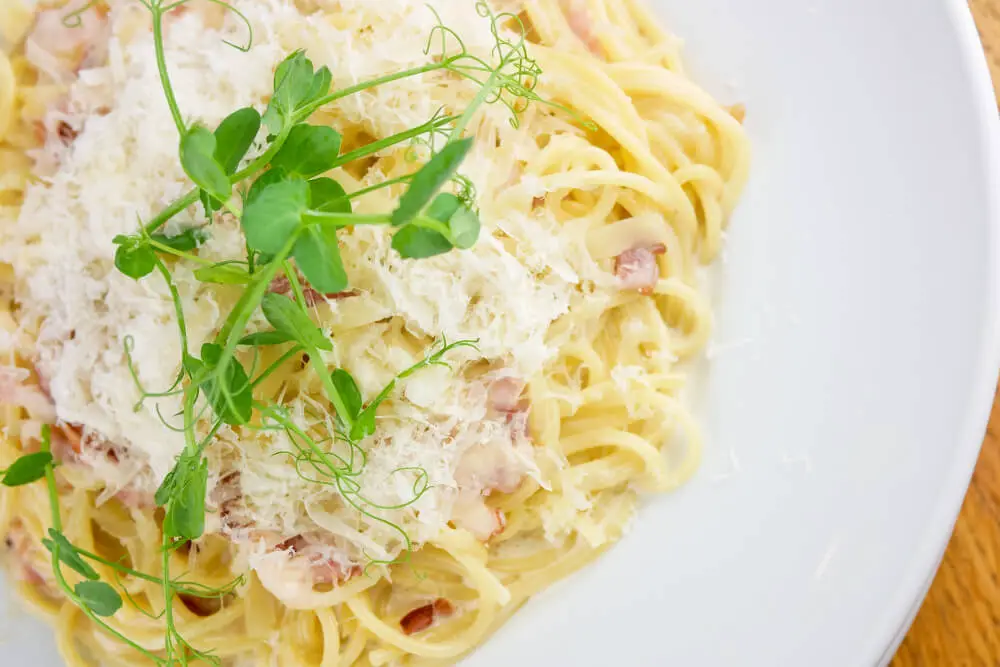Introduction to Alfredo Spaghetti
Alfredo Spaghetti, a dish synonymous with indulgence and comfort, has a rich history and a widespread appeal that transcends international culinary boundaries.
- History and Origin of Alfredo Sauce: The story of Alfredo sauce begins in Rome, Italy, in the early 20th century. Created by Alfredo di Lelio, this sauce was a simple emulsion of butter and Parmesan cheese, initially intended to entice his wife to eat during her pregnancy. The original recipe, known as “Fettuccine al Burro,” gained fame for its creamy texture and delicate flavor. For those interested in exploring different cultural takes on spaghetti, check out Haitian Spaghetti: A Culinary Journey Through Caribbean Flavors.
- Popularity of Alfredo Spaghetti in Different Cuisines: Alfredo sauce has journeyed far beyond its Roman roots, becoming a beloved component in various international cuisines. In the United States, it’s a staple in Italian-American cooking, often served with fettuccine. However, its versatility has allowed it to be adapted into diverse culinary traditions, from being a base in fusion pasta dishes to a decadent topping in contemporary gourmet cooking. Its creamy texture and rich flavor profile have made Alfredo Spaghetti a favorite in households and restaurants worldwide, celebrated for its simplicity and ability to comfort the soul.
Ingredients and Variations for Alfredo Spaghetti
Alfredo Spaghetti, a dish celebrated for its creamy richness, is traditionally made with a few key ingredients. However, its simplicity lends itself to a variety of creative adaptations, catering to diverse tastes and dietary needs.
Classic Ingredients in Alfredo Spaghetti:
The heart of classic Alfredo sauce lies in its minimalism – a luxurious blend of butter, heavy cream, and Parmesan cheese. These ingredients are gently combined to create a smooth, velvety sauce that clings to the pasta, typically fettuccine. Garlic is often added for depth, while a pinch of nutmeg can enhance the sauce’s warmth. The key to its success is the quality of ingredients – fresh, high-quality butter and Parmesan can elevate the dish to new heights.
Variations: Chicken, Shrimp, and Vegetarian Options:
Alfredo Spaghetti is a versatile canvas for various proteins and vegetables.
-
- Chicken Alfredo is a popular variation, where grilled or sautéed chicken breast adds a hearty element to the dish.
- Shrimp Alfredo introduces a seafood twist, with succulent shrimp complementing the creamy sauce.
- For a vegetarian option, roasted vegetables like broccoli, bell peppers, or mushrooms can be added. These not only bring color and texture but also a delightful earthiness to the dish.
Healthier Alternatives and Dietary Adjustments:
While traditional Alfredo sauce is rich in dairy, there are ways to modify the recipe for a healthier version or to accommodate dietary restrictions.
-
- Substituting heavy cream with low-fat milk or a plant-based alternative can reduce the calorie count.
- Using gluten-free pasta makes the dish accessible to those with gluten sensitivities.
- For a vegan version, cashew cream and nutritional yeast can mimic the creamy texture and cheesy flavor of the original sauce.
- Incorporating whole wheat pasta or adding a generous portion of vegetables can increase the dish’s nutritional value, making it a more balanced meal.
These variations and adjustments ensure that Alfredo Spaghetti remains a beloved dish, adaptable to various dietary preferences and health considerations. For more on healthy pasta alternatives, visit Healthline’s Guide to Healthy Pasta and for a unique twist on classic dishes, explore the Green Spaghetti Recipe: A Flavorful Twist on a Classic Dish.
Cooking Techniques for Alfredo Spaghetti
The art of preparing Alfredo Spaghetti lies in mastering a few key cooking techniques. From traditional methods to modern adaptations, the process of making this dish can vary, but the end goal remains the same: a perfectly balanced, creamy pasta dish.
Traditional vs. Modern Cooking Methods:
Traditionally, Alfredo sauce is made by gently melting butter and then whisking in grated Parmesan cheese until it emulsifies into a smooth sauce. This method relies on the heat of freshly cooked pasta to warm the sauce. Modern interpretations, however, often involve cooking the sauce separately, incorporating heavy cream, and sometimes garlic and herbs, for added flavor and richness. While traditional methods emphasize the purity of flavors, modern techniques allow for more versatility and personalization of the dish.
Tips for Perfectly Cooked Pasta:
The foundation of any great Alfredo Spaghetti is perfectly cooked pasta.
-
- Start with a large pot of salted boiling water – the salt enhances the pasta’s flavor, and ample water prevents sticking.
- Use enough water to give the pasta plenty of space to move around.
- Stir the pasta occasionally to ensure even cooking and to keep it from clumping together.
- Cook the pasta until it is al dente – tender but still firm to the bite. This texture is crucial as it holds up well under the rich sauce without becoming mushy.
Sauce Preparation and Consistency:
Achieving the right consistency in Alfredo sauce is key.
-
- Begin by melting butter over low heat to avoid browning.
- Gradually add cream and cheese, stirring continuously. The sauce should be heated gently; too much heat can cause it to separate or become grainy.
- The sauce should coat the back of a spoon but still be liquid enough to mix easily with the pasta.
- If the sauce is too thick, a splash of the pasta’s cooking water can be added to thin it out. This starchy water also helps the sauce adhere to the pasta.
By combining these cooking techniques, whether sticking to tradition or experimenting with modern twists, you can create a dish that is both comforting and indulgently satisfying. The key is to balance the simplicity of the ingredients with careful preparation, resulting in a dish that truly honors the essence of Alfredo Spaghetti. For those who enjoy experimenting, the Ultimate Guide to Fried Spaghetti: A Twist on a Classic offers an exciting variation.
Serving and Presentation for Alfredo Spaghetti
The final flourish to any dish is in its serving and presentation, and Alfredo Spaghetti is no exception. The way it’s plated, the accompaniments chosen, and the wine pairings can elevate this classic dish to a gourmet level.
- Plating Techniques for Alfredo Spaghetti: The beauty of Alfredo Spaghetti lies in its simplicity. When plating, use a twirl method with a fork to create a nest of pasta – this not only looks elegant but also ensures a good sauce-to-pasta ratio in every bite. Place the twirled pasta in the center of a warm plate to maintain its temperature. A sprinkle of freshly grated Parmesan and a garnish of chopped parsley or basil can add color and freshness to the dish.
- Accompaniments and Side Dishes: While Alfredo Spaghetti is a star on its own, certain side dishes can complement its rich flavor. A crisp, green salad dressed with a light vinaigrette balances the creaminess of the pasta. For a heartier meal, garlic bread or bruschetta makes an excellent side, perfect for sopping up any leftover sauce. Steamed or roasted vegetables like asparagus or broccoli also work well, adding a nutritious element to the meal.
By thoughtfully plating, choosing appropriate accompaniments, and selecting the perfect wine, you can elevate Alfredo Spaghetti from a simple pasta dish to an elegant and satisfying meal. For a modern take on pasta dishes that has taken social media by storm, check out the TikTok Spaghetti Recipe: A Viral Sensation.
Alfredo Spaghetti Recipes
Alfredo Spaghetti, known for its creamy, rich sauce, offers versatility and can adapt to suit any taste or occasion. From the classic recipe to quick and creative variations, there’s an Alfredo Spaghetti for everyone.
Classic Alfredo Spaghetti Recipe:
-
- Ingredients: 1 pound of fettuccine pasta, ½ cup of unsalted butter, 1 cup of heavy cream, 1 ½ cups of freshly grated Parmesan cheese, salt, and freshly ground black pepper.
- Instructions:
- Cook the fettuccine in a large pot of salted boiling water until al dente, then drain, reserving some pasta water.
- In a separate pan, melt the butter over medium heat. Add the heavy cream and bring to a simmer.
- As you reduce the heat, gradually add the Parmesan cheese, stirring continuously until it fully melts and the sauce becomes creamy.
- Add the cooked pasta to the sauce, tossing to coat. If the sauce is too thick, add a splash of the reserved pasta water.
- Season with salt and pepper to taste. Serve immediately, garnished with extra Parmesan and a sprinkle of parsley if desired.
Creative Twists on Traditional Recipes:
-
- Chicken and Broccoli Alfredo: Add grilled chicken slices and steamed broccoli to the classic Alfredo for a protein-packed meal.
- Sun-dried Tomato and Spinach Alfredo: Stir in sun-dried tomatoes and fresh spinach for a flavorful and colorful twist.
- Seafood Alfredo: Incorporate a mix of seafood like shrimp, scallops, and crab meat for a luxurious version of the classic dish.
Quick and Easy Alfredo Spaghetti for Busy Weeknights:
-
- Ingredients: 1 pound of spaghetti, 1 jar of quality store-bought Alfredo sauce, 1 cooked chicken breast (optional), 1 cup of frozen peas, salt, and pepper.
- Instructions:
- Cook the spaghetti in salted boiling water until al dente, then drain.
- In a large pan, heat the Alfredo sauce over medium heat. If using, add sliced cooked chicken breast and frozen peas.
- Add the cooked spaghetti to the sauce, tossing to combine.
- Season with salt and pepper to taste. Serve hot for a quick and satisfying meal.
Whether you’re in the mood for the comforting classic or looking for a quick meal solution, these Alfredo Spaghetti recipes offer something for every palate and schedule. They demonstrate the dish’s ability to be both a gourmet experience and a weeknight lifesaver.
FAQs
- What’s the best pasta for Alfredo sauce?
- Although traditional recipes call for fettuccine, feel free to use any type of pasta you prefer. The key is to choose a shape that holds the sauce well, like penne or linguine.
- Can I make Alfredo sauce without heavy cream?
- Yes, you can use milk thickened with a roux (butter and flour mixture) as a lighter alternative.
- Why does my Alfredo sauce get clumpy?
- This usually happens if you add the cheese too quickly or set the heat too high. Add cheese gradually and keep the heat low.


